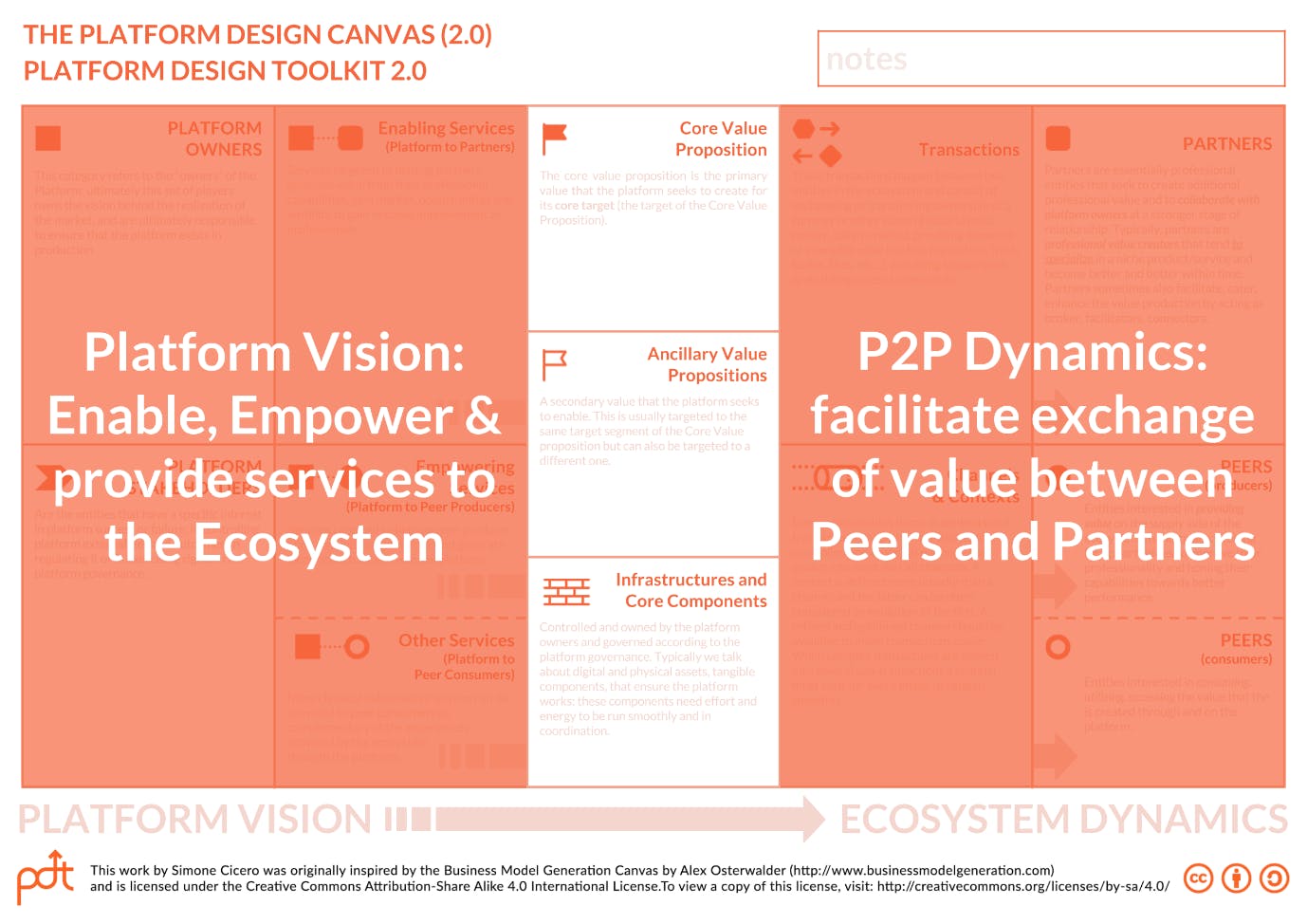How to design your marketplace idea
A guest post by Simone Cicero, creator of the Platform Design Toolkit, a methodology and set of practical tools that help platform businesses create value.
Published on
Last updated on
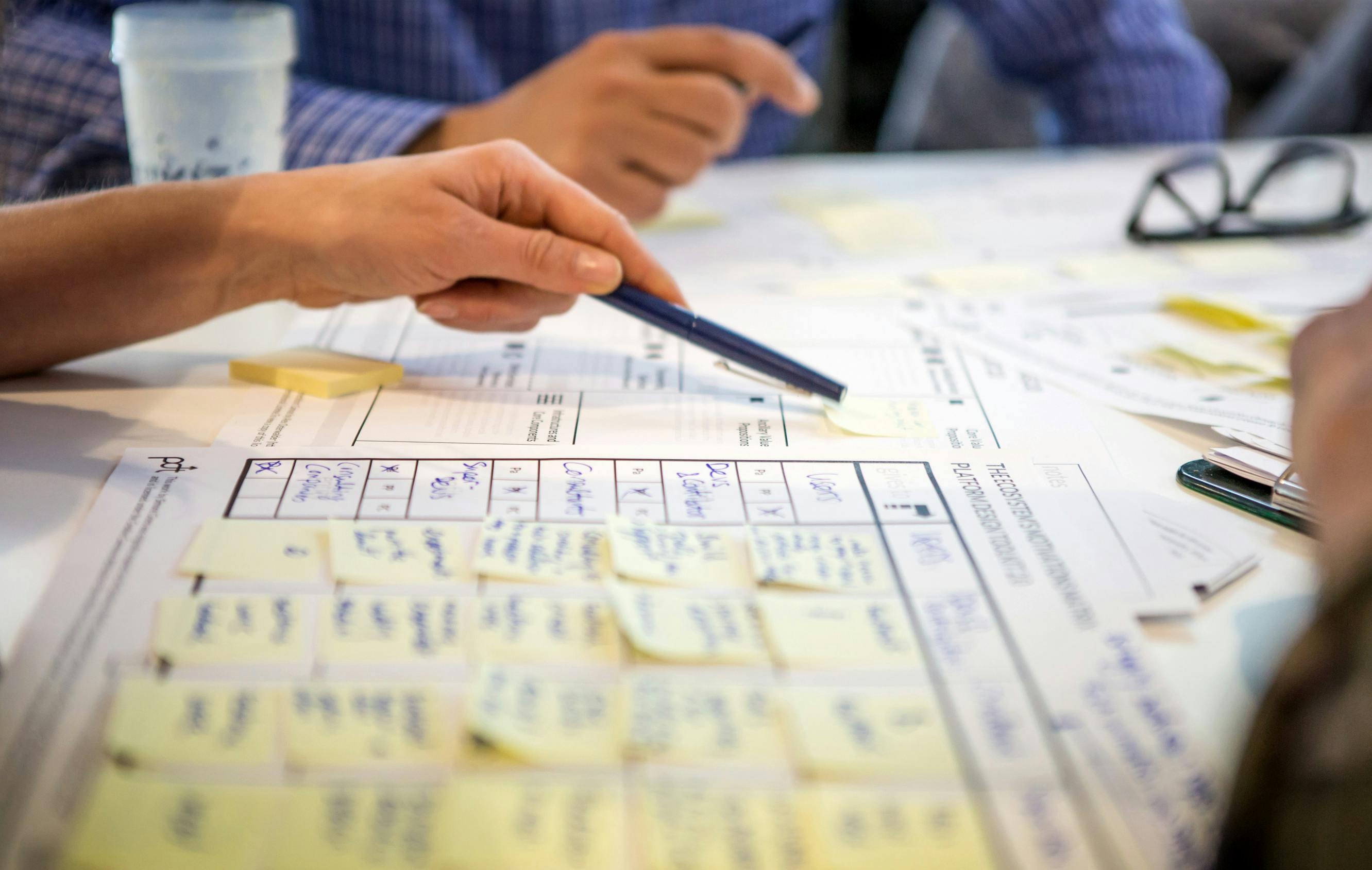
This is a guest post by Simone Cicero, creator of the Platform Design Toolkit, a methodology and set of practical tools that help platform businesses create their strategy. For more tips on growing your business, check out the marketplace marketing & growth articles library.
With the Platform Design Toolkit, we wanted to make a methodology that’s actionable, simple, and accessible to everyone—something that goes beyond the existing literature on platforms and peer-to-peer marketplaces.
When we use the Platform Design Toolkit to approach the envisioning or rethinking of a marketplace, we recommend going through three phases to approach this challenging task.
The first phase is always about Building Awareness: understanding what the target market opportunity for this marketplace move is, what value needs to be created and how it fits with the existing market/society dynamics, and what leverage points can be used. A full Platform Design session follows: implementing the whole set of canvases and converging them into a consolidated Platform Design Canvas—one that gives you a full overview of the message your marketplace wants to convey to the participants in the ecosystem. A moment of Action-Oriented Strategy building is next helping you identify and prioritize a set of key actions that the team needs to get done to start making the vision a reality.
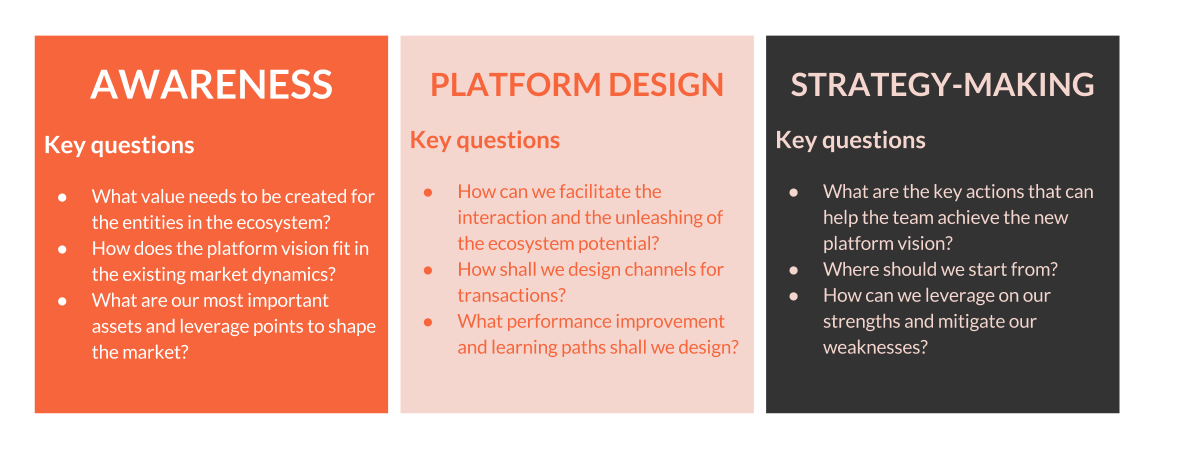
Let's now go over these three steps in detail.
For this initial phase, we use a wide set of tools. This phase is really key, especially for existing marketplaces that are looking for a pivoting strategy. If you are struggling for growth, it usually means that the platform-marketplace still hasn't found the real value the participants in the ecosystem are looking for. We have recently been using Empathy Maps to assess how the players in the ecosystem feel and what their perception of value that we need to design a value proposition for is. Empathy maps are great general tools to understand what the expectations, needs, and desires of users are, but based on our research and insights from using Empathy Maps, we have developed a new, dedicated user research tool that is designed with platform thinking in mind: the Ecosystem Entity Portrait.

Thanks to this still experimental tool, you can create a portrait of every entity in the ecosystem. The word “portrait” wasn't chosen by chance: portraits have the capacity to bring you in deep empathic contact with the subject and can help you identify with them. That’s what the Entity Portrait is for: to make yourself (as a platform-marketplace's designer) better acquainted with the ecosystem of entity-participants that are not only recipients but also co-creators of the marketplace's story, to understand their motivations, hopes and the value they seek.
With the Entity Portrait, start by making an analysis of the three essential aspects of the living context of the entity (participant): their current goals, the performance pressures, and leverageable assets and capabilities. The portrait will then help you look into the three essential gains from your platform: the convenience gains, the access & reach gains, and the general value gains. To learn more about these, read this introduction post on the Stories of Platform Design blog.
Beyond looking into a participant’s perception of value, another approach we normally adopt during the awareness phase of marketplace envisioning is Value Chain Mapping. This technique by Simon Wardley (a source of continuous inspiration for us) is quite demanding but can be incredibly valuable during the awareness phase.
Value Chains are made up of a connection of activities and resources, from the very basic infrastructural level up to the customer. Through Wardley’s maps, you can understand where in the value chain your platform will be located. Are you targeting a mature, commoditized space, with high competition and lower margins? Or are you looking at the top of the value chain where you can generate tangible, customer-focused value?
To better understand what I mean, think about it like this: you may well choose to create a new platform for peer to peer logistics or energy production but—in that case—you would be competing with well-established giants that have evolved their business processes for decades and transformed the product into a utility, i.e.something cheap and available everywhere. End users will most likely feel that your service is a commodity rather than a value-added service. It will be very hard to compete (in terms of performance) with well-integrated and efficient, industrialized giants. Better to look higher up in the value chain to aspects that are more closely related to human experiences, where the perceived value is higher and personalization (efficacy) trumps efficiency.
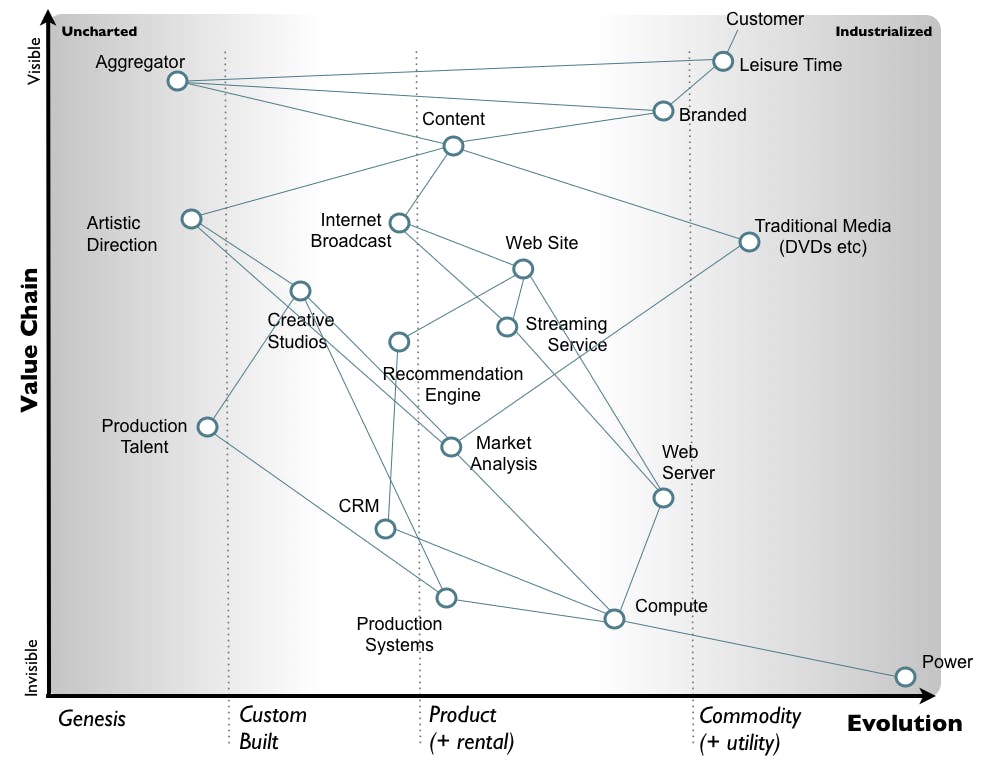
Beyond looking for external awareness (what’s valuable on the market), we also try to build awareness on the internal side of the company or team. With techniques inspired by Resource Based View analysis or VRIO question framework, we always try to assess the internal resources of founding teams or organizations with the objective of assessing how these resources could represent an unfair advantage in the context of the market that the team wants to shape with their platform.
After having increased awareness of both the external and internal domains, we proceed into the formal Platform Design process as detailed in our guidelines available in the Platform Design Toolkit download pack.
The Platform Design Toolkit guides you through a four-step process, leveraging a consolidated set of tools that thousands are using all over the world: ecosystem mapping, motivation analysis, transaction engine and learning engine design. Indeed, our theory of platforms and marketplaces doesn’t just consider them to be a place where two sides of a market opportunity can meet and share value units through channels (a transaction engine), but also a place that helps participants evolve through a performance improvement and learning process. Here’s where your platform strategy can really make a difference: what are the services you need to put in place to sustain your ecosystem evolution?
The envisioning of your marketplace starts with mapping the roles that participants can play in it. Thanks to the Ecosystem Map and Motivations Matrix, you can map both sides of your marketplace opportunity (producers and consumers) and identify the motivations and the unexpressed potential that they hold that—if connected—could start pulsating in your marketplace. That’s why we often say that platform-marketplace design differs from product-service design in a few ways: with the latter you design to solve someone’s problems, while with the former you design to unlock sleeping potential.
After the first “picture” of the ecosystem, the process goes through motivation analysis (trying to understand what players could potentially exchange and what motivates them), which is then consolidated and converged into a simple transactions model. That’s another key lesson for designing a marketplace: simplicity rules. We likely have grand ideas for platform-powered marketplaces but, when it comes to discovery and validation, you’ll need to go step by step, prototyping features and transaction channels one by one.
All these steps build the content of the Platform Design Canvas. In the end, it forms a complete picture of your platform's vision.
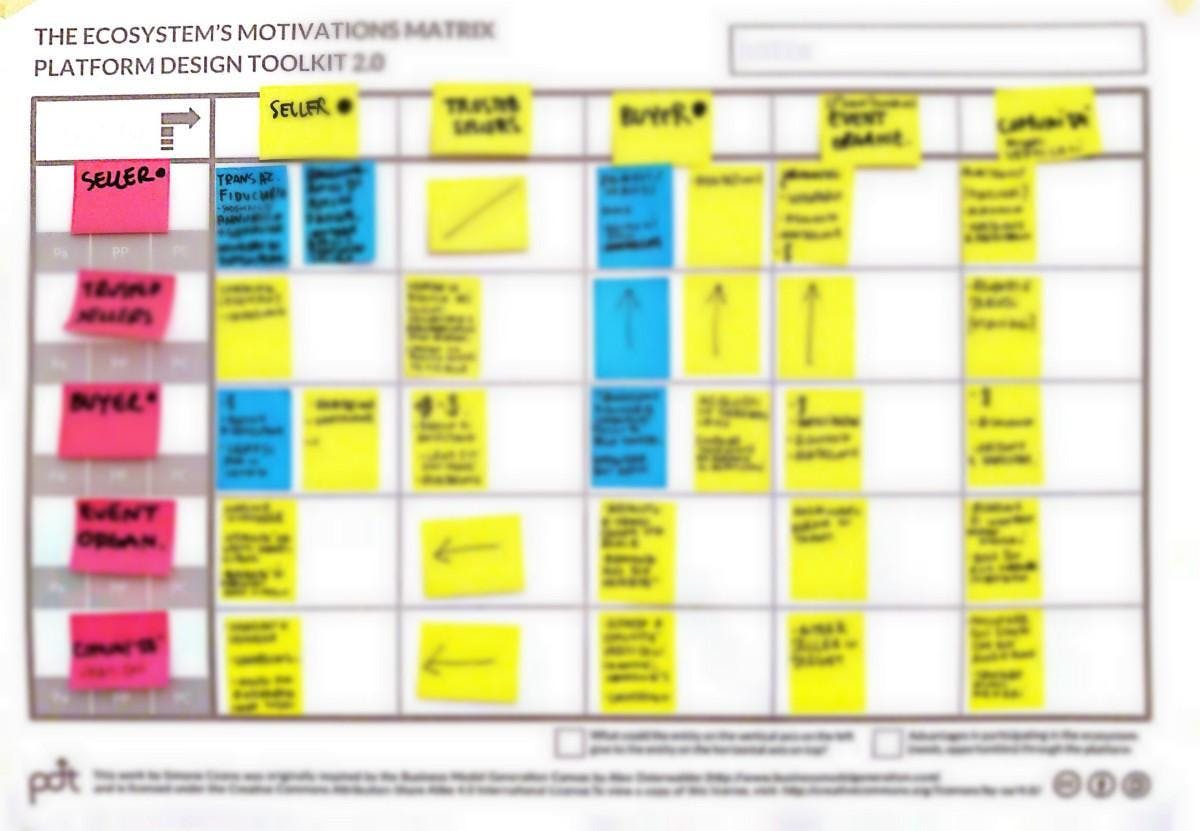
When running workshops with customers that want to rethink an existing marketplace that shows signs of lagging growth, we usually use a visual trick to make it easier to think in differential steps. If you print the Platform Design Toolkit canvases in large enough sizes — we usually use A3 or A2 prints — you can fill in the blanks with small post-its. By using post-its of different colors for existing features and for the new or differential ones (those needing adjustments), you can easily see how different your new platform vision needs to be from your current one and help you in the action-oriented strategy making session.
Additionally, especially if you are doing a check-up of an existing platform marketplace, you should focus on a few questions during your platform design:
Is your marketplace already driving network effects?
Is there single user utility for the side of the market that will generate attraction to the other side? If, for example, you hypothesize that growth in supply will generate more demand, will entities from the supply side find enough value to join your marketplace even without stable demand?
Try to include a curated selection of offers from the supply/producer side of the ecosystem to attract the first players on the demand side, even if your marketplace does not yet have critical mass.
Are there any design-driven blocks that are holding back growth?
In some cases, your design choices may be holding growth back. As an example, you may have hypothesized that people won’t make transactions across cities and therefore limited the marketplace size to a city. Or maybe you thought that a transaction won’t happen if people are not Facebook friends. Try to validate your hypotheses and don't take anything for granted.
To build marketplace trust, is there a reputation creation process in place on your marketplace?
Reputation is essential in marketplaces as it helps the best providers to emerge. It is essential for your marketplace to have a mechanism in place that can generate reputation for both sides of the market—or, at least, for the supply side to allow consumers to pick the best offers.
Is your marketplace lowering access barriers for entry in both the demand and supply sides?
Platform-enabled marketplaces work best when they use technology and design to reduce the barriers to entry to a given market. For example, by enabling non-professional producers to gradually become professionals, like with the case of Etsy and amateur crafters. Normally, the price you offer to the consumer side (demand) needs to be lower than the one they could get by sourcing their services from traditional providers.
Are the right filters available?
Do you actively help the players on the demand side of your ecosystem filter out the wrong offers and find the right one for them?
Once you’ve got your strategic vision and the design of the marketplace platform you want to build, you’ll likely end up with lots of actions to take. At Platform Design Toolkit, we’re currently working on extending our toolkit to help you start lean prototyping (based on the Customer Development practice) of the new or modified elements that were identified in the design phase. Still, your list of actions will likely extend further than prototyping, and will include aspects such as building a stronger team, partnering, marketing, and more.
This is how we normally close our platform strategy workshops: trying to help our customers prioritize essential actions needed to make their vision a reality. We've lately been using a very straightforward practice to identify and prioritize actions. This practice is universal and not strictly related to the Platform Design efforts—I’m sure some of you may want to use it in other contexts.
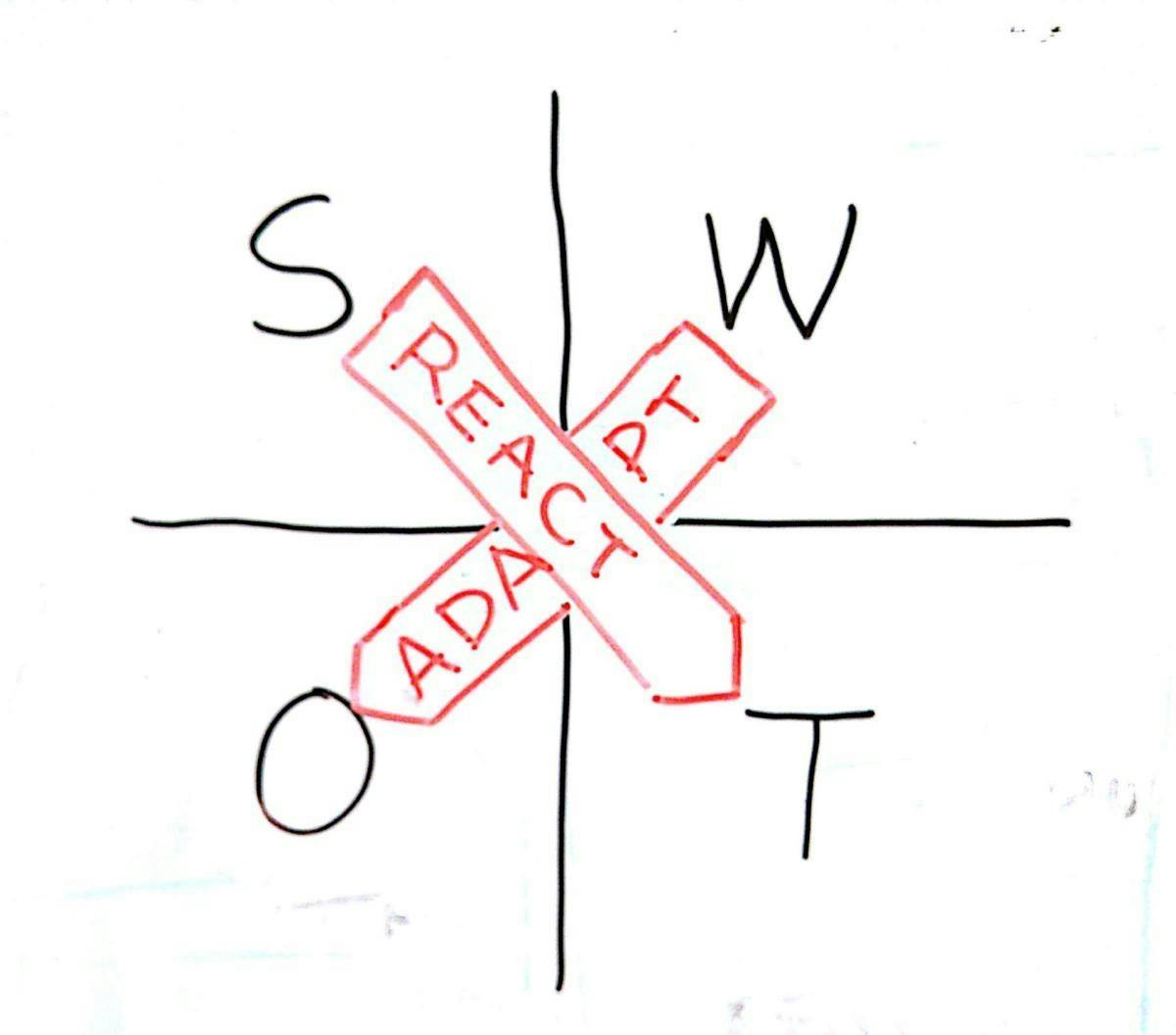
We first compile — in team-wide co-creation — a SWOT matrix: we aim to track the internal (strenghts and weaknesses) and external (opportunities and threats) forces that operate in the context of the differential improvements or new platform implementation. What are the forces and elements that prevent the team from the realization of the vision? Which ones support this evolution?
After having done the SWOT analysis, we complement it with a REACT-ADAPT analysis that essentially connects the internal forces to external ones:
- What actions can help the team use its strengths to react to external threats? (REACT)
- What actions can help the team mitigate its weaknesses to increase the possibility to catch the opportunities? (ADAPT)
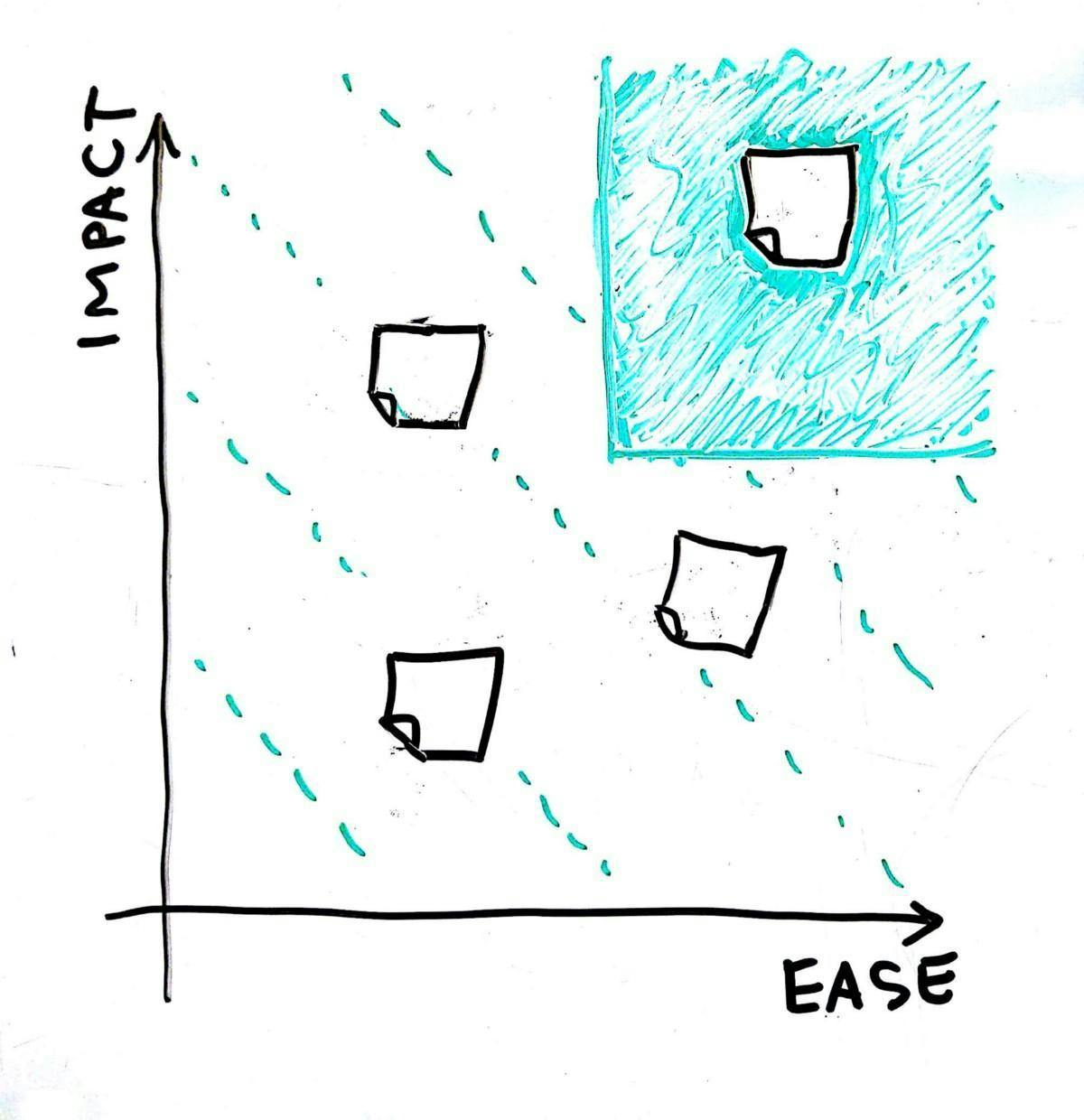
This exercise will lead to a number of key actions. We normally complement it with a further prioritization of activities with a simple impact/ease quadrant: you draw a quadrant based on two axes, impact (the importance of the action, as felt by the team, with regards to the transformative vision) and ease of achieving (the inverse of the complexity of the action based on the effort needed, capital and resources needed, etc.), and then place your tasks on the graph. This will help you find the “low hanging fruits” (low complexity, high impact, the greenish zone in the upper right corner of the image above) and build an idea of the actions you need to take first.
When it comes to features, we always suggest our customers adopt a lean startup approach—or, more precisely, Customer Development to gradually develop their platform, starting from the validation of the platform value propositions towards all the players (demand and supply). Customer Development leads you, step by step, through a validation phase that will save you money by not building things that people don’t want.
In the future we're going to provide easy to use tools that will guide the Platform Design Toolkit adopters further the strategic envisioning into validation, prototyping and growth hacking.
You might also like...

Marketplace metrics: 26 key metrics and how to use them
What metrics should a marketplace founder track? And how to translate what you track into action? Here’s how to identify and track the key metrics, how to separate them from vanity metrics, and how to make concrete decisions based on reliable data.

Ten Lessons Learned Investing in early-stage Marketplaces
Investor Mathias Ockenfels’ insightful lessons are worth every marketplace entrepreneur’s time.

Growing with content - An interview with Simon Powell
The founder of TransferTravel reveals how creating content helped them build supply and awareness about their marketplace, up to 30,000 visitors per month, without spending anything on ads.
Start your 14-day free trial
Create a marketplace today!
- Launch quickly, without coding
- Extend infinitely
- Scale to any size
No credit card required

